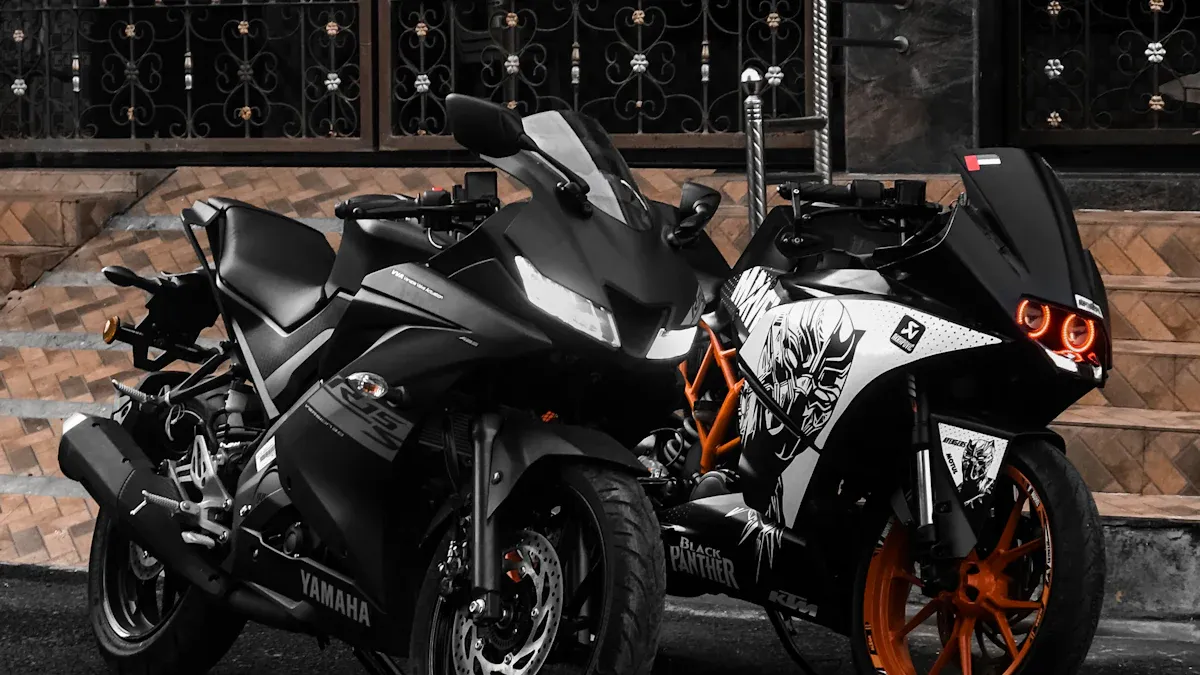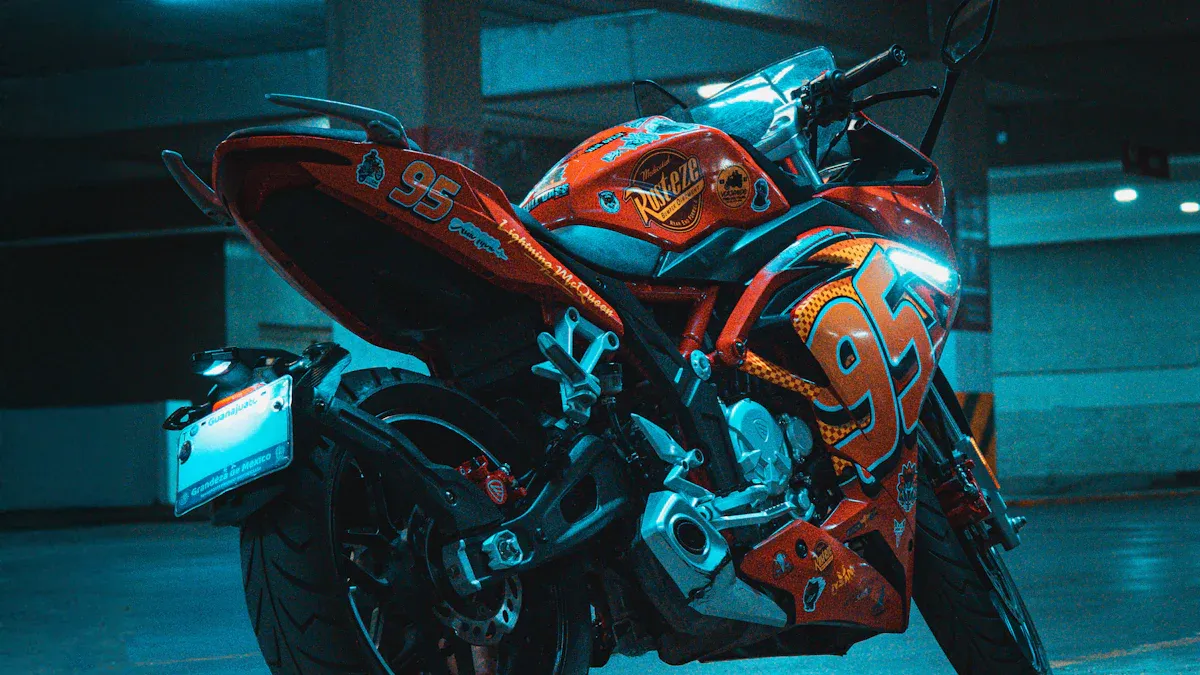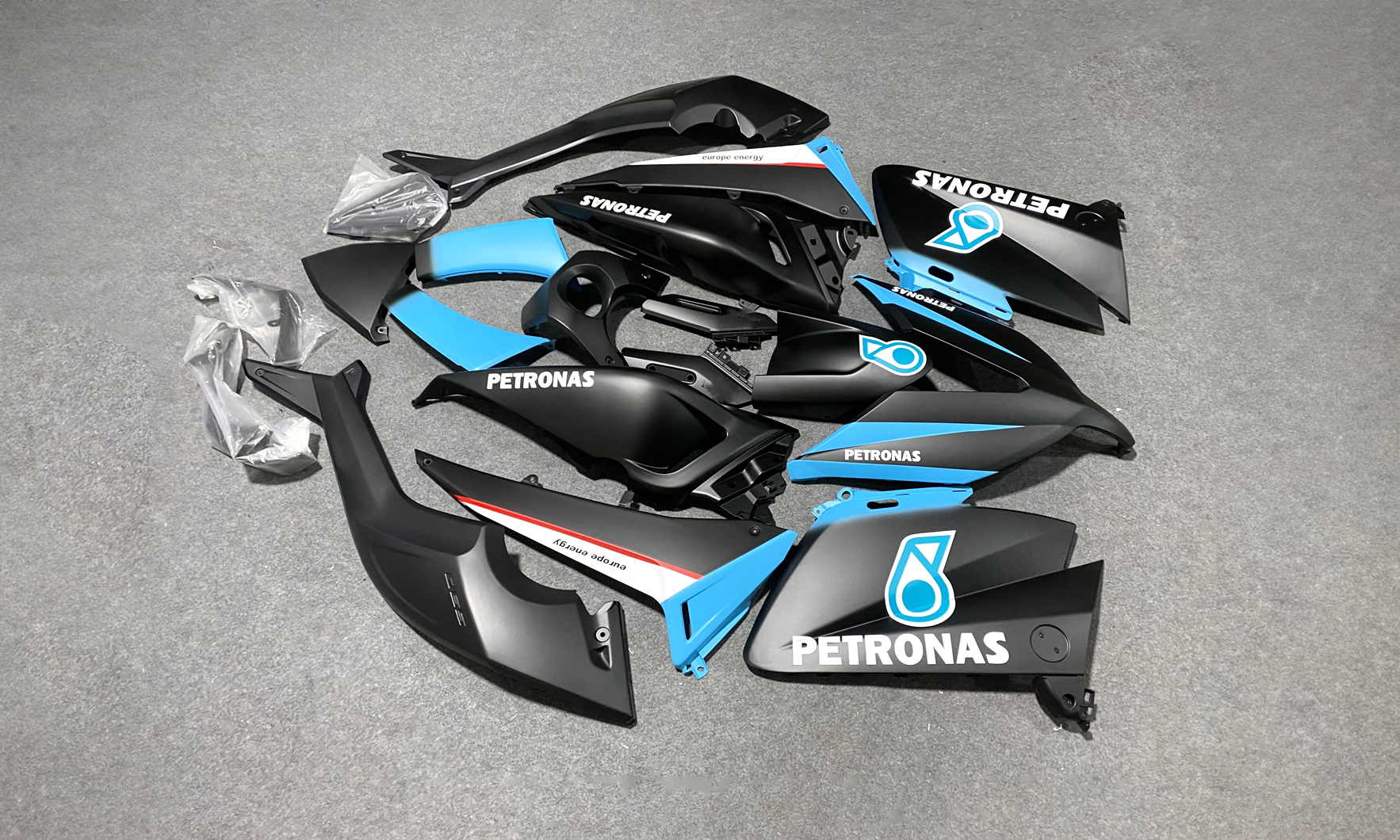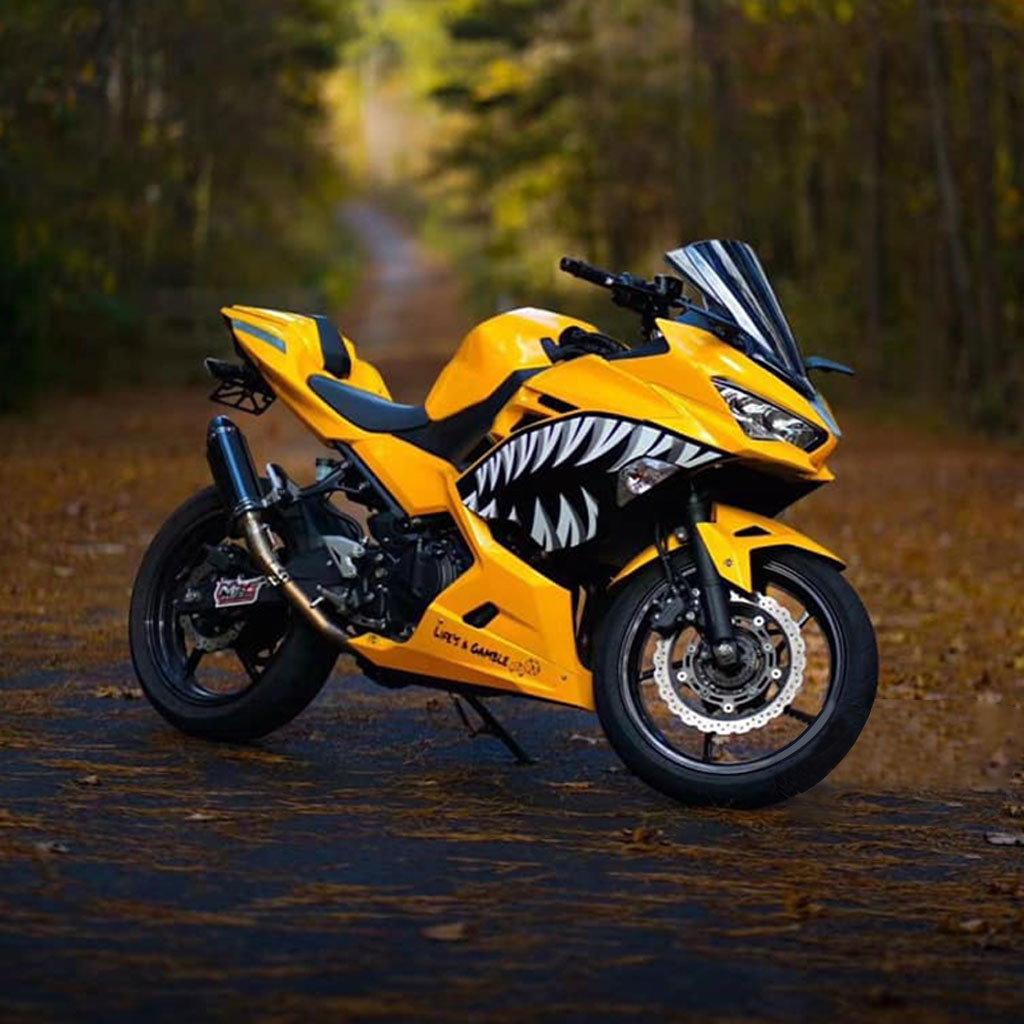OEM vs Aftermarket Fairings: Choosing the Right Kit for Your Bike

Choosing fairings for your bike isn’t only about style. It’s also about how well they work, last, and cost. OEM and aftermarket fairings each have good and bad points. OEM fairings fit perfectly and are made like factory ones. Aftermarket fairings give you more choices and cost less. Your choice can change how your bike runs and what you pay. So, how do you pick? Let’s explain it further.
Key Takeaways
OEM fairings fit perfectly and are high quality. They make your bike look and work like new.
Aftermarket fairings cost less and come in many styles. They let you customize your bike.
Think about your budget and how you ride before choosing. OEM is dependable, but aftermarket saves money.
Always make sure the fairings match your bike's make and model. This helps avoid fitting problems.
Look up reviews for aftermarket fairings to check their quality. This helps you avoid bad products.
Understanding OEM Fairings

What Are OEM Fairings
OEM fairings are the real deal. They’re made by the original equipment manufacturer, which means they’re the same parts your bike came with when it rolled off the factory floor. These fairings are designed specifically for your bike model, so they fit perfectly without any adjustments. Think of them as the gold standard for replacement parts. When you choose OEM fairings, you’re essentially getting a replica of the original design, down to the smallest detail.
Why does this matter? It’s all about consistency. OEM parts ensure your bike looks and performs just like it did when it was brand new. If you’re someone who values keeping your bike as close to its original state as possible, OEM fairings are the way to go.
Benefits of OEM Fairings
So, why should you consider OEM fairings? First, they offer unmatched quality. Since they’re made by the same company that built your bike, you can trust their durability and performance. They’re built to last and handle the wear and tear of regular riding.
Another big plus is the fitment. With OEM fairings, you won’t have to worry about gaps, misalignments, or modifications. They snap into place like puzzle pieces. This saves you time and effort during installation.
Lastly, OEM parts often come with a warranty. This gives you peace of mind, knowing you’re covered if something goes wrong. While they might cost more upfront, the reliability and support make them a smart investment.
Key Features of OEM Fairings
OEM fairings stand out for several reasons. First, their precision fitment ensures they align perfectly with your bike’s frame. This not only looks great but also improves aerodynamics. Second, they’re made from high-quality materials that match the original design. This means they can withstand harsh weather, road debris, and other challenges.
Another key feature is their compatibility. OEM fairings are tailored for specific bike models, so you won’t have to guess whether they’ll work with your ride. Plus, they often come pre-painted to match your bike’s color scheme, saving you the hassle of custom painting.
In short, OEM fairings combine quality, reliability, and ease of use. They’re a top choice if you want to maintain your bike’s original look and performance.
Exploring Aftermarket Fairings
What Are Aftermarket Fairings
Aftermarket fairings are parts made by other companies, not the bike’s maker. They are built to fit many motorcycle models and are a cheaper option than OEM fairings. Riders like them for customizing their bikes or saving money. Unlike OEM fairings, aftermarket ones come in different styles, materials, and finishes. This lets you make your bike look unique.
The aftermarket business has grown a lot over time. It’s not just for motorcycles—airplanes also use aftermarket fairings for repairs and upkeep. This shows how important aftermarket parts are in many industries. For motorcycles, aftermarket fairings are a popular choice for riders who want to save money and add personal touches.
Advantages of Aftermarket Fairings
Why pick aftermarket fairings? First, they cost less. You can find good-quality ones for much cheaper than OEM parts. This is helpful if you’re on a budget. Second, they offer more choices. Whether you want a cool carbon fiber look or a bright custom design, there’s something for you.
They also improve performance. Some aftermarket fairings, like carbon fiber ones, are lighter and stronger. This helps your bike go faster, use less fuel, and handle better. Racers like these fairings because they reduce shaking and improve speed. Sometimes, aftermarket fairings last longer than OEM ones.
Common Drawbacks of Aftermarket Fairings
Aftermarket fairings have downsides too. One problem is they might not fit perfectly. Since they aren’t made just for your bike, you may need to adjust them. This can be hard if you’re not good with tools or don’t want to spend extra time.
Another issue is quality. Some aftermarket fairings are great, but others aren’t as good as OEM ones. You’ll need to check reviews to avoid bad products. Also, aftermarket fairings usually don’t have warranties. If they break, you’ll have to fix them yourself. This can be risky if you’re trying a new brand.
In summary, aftermarket fairings are cheaper and offer more styles. But they might need extra work to fit and may not always be reliable.
Comparing OEM and Aftermarket Fairings
Quality and Fitment

OEM and aftermarket fairings differ in quality and fit. OEM fairings are made by your bike’s manufacturer. They fit perfectly without gaps or adjustments. This makes installation quick and easy.
Aftermarket fairings vary in quality. Some are better than OEM, with smoother finishes and better aerodynamics. But not all aftermarket fairings fit well. You might need to adjust them, which can be tricky if you’re not good with tools.
If you want a perfect fit and easy setup, choose OEM. If you don’t mind extra work, aftermarket fairings can offer unique looks and better performance.
Cost and Value
OEM fairings cost more, usually $500 to $1,500. They are high-quality, fit well, and often come with a warranty. If you want long-lasting parts, the higher price is worth it.
Aftermarket fairings are cheaper, costing $300 to $700. They are great for saving money. Some are made from lightweight materials like carbon fiber, which boosts performance. But you need to research to avoid poor-quality ones.
OEM fairings are expensive but reliable. Aftermarket fairings save money but may have risks.
Availability and Variety
Aftermarket fairings are easier to find. Many companies make them, even for older bikes. They come in many colors and designs, letting you customize your bike.
OEM fairings match your bike’s original look. They are great for keeping the factory style. But they don’t offer many design options and can be hard to find for older bikes.
If you want more choices and custom designs, go for aftermarket fairings. If you prefer the original look, OEM fairings are better.
Warranty and Risk
When thinking about warranty and risk, your choice matters a lot. Let’s make it simple to understand what works best for you.
Warranty Coverage: What Do You Get?
OEM fairings often include a warranty from the maker. This means if there’s a problem, like a defect, you’re protected. These warranties can last a year or more. It shows the company trusts its product and gives you confidence.
Aftermarket fairings don’t always have warranties. Some good brands might offer limited coverage, but it’s not as strong as OEM warranties. Cheaper aftermarket fairings? They rarely come with any guarantees. If they break, you’ll have to fix or replace them yourself.
Risk Factors: What Could Go Wrong?
Aftermarket fairings can come with risks. Poor fit is a common problem, especially with cheaper ones. You might need to adjust or modify them, which can be annoying. Also, low-cost aftermarket fairings often use weak materials. They might fade, crack, or bend in tough conditions.
OEM fairings lower these risks. They are made to fit perfectly, so no adjustments are needed. The materials are strong and last long, even in bad weather. While they cost more, they save you trouble later.
Comparing Warranty and Risk Factors
Here’s a simple table to compare:
Feature | OEM Fairings | Good Aftermarket Fairings | Cheap Aftermarket Fairings |
|---|---|---|---|
Material Strength | High-quality, factory-standard materials | Good but may vary slightly | Weak, low-quality materials |
Testing & Certification | Meets strict factory standards | Certified by trusted third parties | No proof of quality or testing |
Brand Trust | Reliable, well-known brands | Trusted brands with good reviews | Unknown brands with little information |
Cost | Expensive but lasts longer | Affordable with decent value | Very cheap but less durable |
Tip: If you choose aftermarket fairings, go for trusted brands. Check reviews and certifications to avoid bad products.
Final Thoughts on Warranty and Risk
If you want something reliable and long-lasting, OEM fairings are the safest choice. They come with strong warranties and fewer risks. But if you’re on a budget and do your homework, good aftermarket fairings can work well. Just avoid very cheap ones—they might cost you more later.
So, what matters more to you: safety or saving money? Your answer will help you decide.
Choosing the Right Fairing Kit
Think About Your Needs and Budget
Before picking a fairing kit, think about what you need. Do you want a factory-style look or something custom? Your riding style matters too. Daily riders need durable and well-fitting fairings. Racers might prefer lightweight materials like carbon fiber.
Your budget is important. OEM fairings are strong but cost more. Aftermarket fairings are cheaper and offer more choices. But not all aftermarket kits are good quality. A cheap kit might break easily and cost more later.
Tip: Write down your priorities like style, durability, or cost. This helps you choose wisely and avoid spending too much.
Match Fairings to Your Bike
Fairings don’t fit every bike. Check your motorcycle’s make, model, and year. OEM fairings fit perfectly because they’re made for your bike. Some aftermarket fairings, like Nicefairings, can also match your bike’s specs. Some brands let you design your own look.
Sportbikes need aerodynamic fairings for speed. Touring bikes need bigger fairings for wind protection. Cruisers look great with simple, classic fairings. Picking the right type improves fit and performance.
Note: Always check if the fairing fits your bike. Badly fitting fairings can hurt safety and aerodynamics.
Balance Cost and Long-Term Value
Think about more than just the price. OEM fairings last longer and often have warranties. High-quality aftermarket fairings can be durable and cost less. But cheap aftermarket kits might wear out fast and need replacing.
Here’s a table to help you decide:
What It Means | |
|---|---|
Location | How close the seller is and shipping costs. |
Cost structure | Total price, including production and delivery. |
Quality capabilities | Systems to ensure good quality and reliability. |
Warranty | Whether the product has warranty coverage. |
Environmental compliance | If the company follows eco-friendly rules. |
Technology and process | Advanced tools and methods for making fairings. |
By thinking about these factors, you can make a smart choice. Trusted brands like Nicefairings offer custom designs and good quality.
Pro Tip: Don’t just look at the price. Think about how the fairings will work over time and if they fit your riding needs.
Deciding between OEM and aftermarket fairings depends on your priorities. OEM fairings fit perfectly, are very durable, and reliable. On the other hand, aftermarket fairings are cheaper and offer more styles. Both have good and bad points.
Tip: Think about how you ride, your budget, and if you’re okay with extra work during installation.
If you want something easy to install and long-lasting, go with OEM fairings. But if you want to save money or make your bike unique, good-quality aftermarket fairings are a smart pick. Take your time, compare options, and choose what works best for you and your bike!
FAQ
1. Can I use both OEM and aftermarket fairings together?
Yes, you can mix them. But it might change how your bike looks and fits. OEM fairings fit perfectly, while aftermarket ones might need adjustments. If you mix, pick good-quality aftermarket fairings to avoid problems.
2. Are aftermarket fairings okay for everyday riding?
Yes! Many aftermarket fairings are strong and safe for daily use. Just pick a trusted brand with good reviews. Stay away from very cheap ones, as they might not last long with regular use.
3. How can I check if a fairing fits my bike?
Look at the product details to see if it matches your bike’s make, model, and year. OEM fairings always fit perfectly. For aftermarket fairings, check the specs or ask the seller to confirm.
Tip: Double-check the measurements before buying to avoid fitting problems.
4. Do I need a mechanic to install aftermarket fairings?
Not always. Some aftermarket fairings have pre-drilled holes and clear instructions, so you can install them yourself. Others might need changes, and you may need a mechanic. If unsure, ask a professional for help.
5. Which is better: ABS plastic or carbon fiber?
It depends on what you need. ABS plastic is cheap, strong, and good for daily rides. Carbon fiber is light and boosts performance, making it great for racing. Pick based on your budget and riding style.
Note: Carbon fiber costs more but improves speed and aerodynamics.
See Also
Tips for Choosing the Perfect Fairing Kit for Your Motorcycle
Comparing OEM and Aftermarket Fairings for Ninja 500 Motorcycles
Finding Budget-Friendly Motorcycle Fairings for Your Ride
Nicefairings or Monsterfairings: Which Fairings Are Superior?

